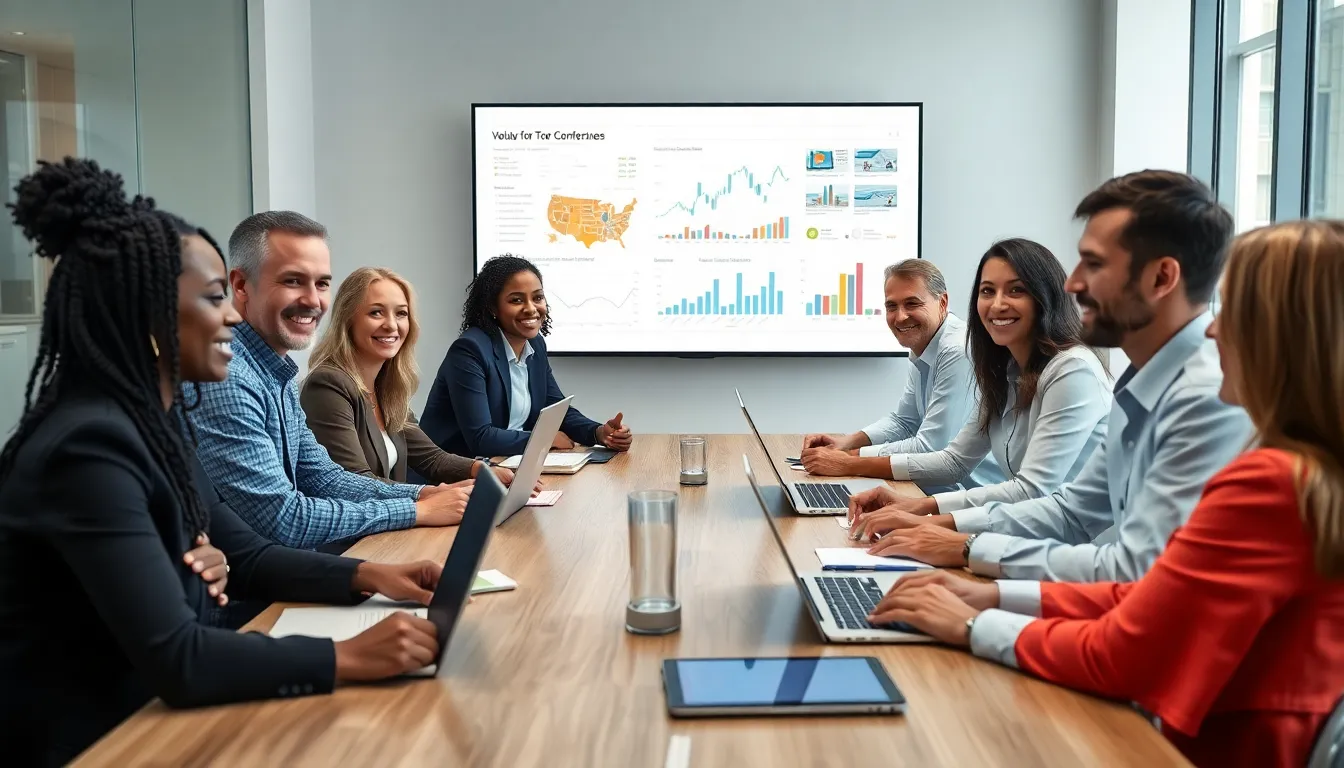In today’s fast-paced work environment, efficient collaboration isn’t just a buzzword; it’s a necessity. Teams are increasingly spread across different locations and time zones, making effective communication and cooperation crucial for success. The ability to work seamlessly together can lead to enhanced productivity, innovation, and ultimately, better results.
Embracing the right tools and strategies can transform how teams collaborate. From cloud-based platforms to agile methodologies, organizations that prioritize efficient collaboration can navigate challenges with ease. This article explores the key elements that foster effective teamwork, ensuring that every member contributes their best while driving towards common goals.
Table of Contents
ToggleUnderstanding Efficient Collaboration
Efficient collaboration involves clear communication and coordinated efforts among team members to achieve common objectives. It streamlines processes and enhances productivity within diverse team environments.
Definition of Efficient Collaboration
Efficient collaboration refers to the ability of individuals or teams to work effectively together towards shared goals while minimizing misunderstandings and maximizing resource use. It encompasses structured communication, task management, and a supportive environment that fosters creativity and innovation. Efficient collaboration utilizes tools and frameworks that keep team members connected, such as project management software, messaging platforms, and cloud storage solutions.
Importance of Efficient Collaboration
Efficient collaboration plays a critical role in enhancing productivity and achieving successful outcomes. Key reasons include:
- Increased Productivity: Team members share responsibilities and leverage each other’s strengths, leading to faster completion of tasks.
- Enhanced Innovation: Collaboration encourages diverse perspectives, resulting in creative solutions and improved problem-solving.
- Improved Communication: Open lines of communication reduce errors and misunderstandings, ensuring everyone remains aligned with project objectives.
- Flexibility and Adaptability: Efficient collaboration allows teams to respond quickly to changes and new challenges while maintaining focus on goals.
- Stronger Relationships: Collaborative work builds trust and rapport among team members, fostering a positive work culture.
Acknowledging the importance of efficient collaboration enables organizations to implement effective strategies and tools, paving the way to success in today’s dynamic environment.
Key Components of Efficient Collaboration

Efficient collaboration hinges on several critical components that enhance teamwork and productivity. Understanding and implementing these components leads to better outcomes in a diverse work environment.
Effective Communication
Effective communication serves as the foundation of efficient collaboration. Clear, concise messaging ensures that all team members understand objectives and expectations. Regular updates through channels like instant messaging, emails, and video conferences maintain alignment and engagement. Encouraging feedback fosters an open dialogue, allowing for the swift resolution of misunderstandings. Utilizing visual aids and collaborative documents increases clarity, providing everyone with access to the same information. Implementing structured communication protocols, such as daily stand-ups or weekly check-ins, can streamline information sharing and strengthen team cohesion.
Trust and Respect Among Team Members
Trust and respect among team members form the bedrock of collaboration. When team members trust each other’s skills, judgment, and intentions, they are more likely to share ideas openly and constructively. Building trust requires consistent behavior, transparency in decision-making, and recognizing individual contributions. Respecting diverse perspectives and expertise cultivates an inclusive environment where innovation thrives. Establishing team norms that prioritize mutual respect reinforces these principles, ensuring that everyone feels valued and empowered to contribute. Encouraging social interactions and team-building activities can further solidify relationships and enhance overall trust within the group.
Tools for Efficient Collaboration
Utilizing the right tools enhances team cooperation and communication, leading to improved productivity. Various digital platforms and software options support efficient collaboration in diverse work environments.
Digital Collaboration Tools
Digital collaboration tools streamline communication and information sharing among team members. Examples of effective tools include:
- Slack: Facilitates real-time messaging and file sharing, promoting quick exchanges and group discussions.
- Microsoft Teams: Integrates chat, video conferencing, and file collaboration, enabling seamless teamwork across different locations.
- Google Workspace: Offers cloud-based apps like Docs and Sheets for collaborative document editing and storage, allowing multiple users to work simultaneously.
These tools foster transparency and engagement by allowing team members to easily share updates and resources.
Project Management Software
Project management software organizes tasks, deadlines, and team assignments, enhancing overall workflow. Prominent examples include:
- Asana: Enables teams to create projects, assign tasks, and track progress through customizable workflows and timelines.
- Trello: Uses boards and cards for visual project management, simplifying task tracking and prioritization.
- Monday.com: Offers a flexible platform for managing tasks and collaboration, accommodating various team workflows.
Such software improves accountability and clarity in project roles, ensuring that everyone remains aligned on goals and deadlines.
Best Practices for Fostering Efficient Collaboration
Fostering efficient collaboration involves implementing effective strategies. Adopting best practices enhances teamwork and drives productivity across dispersed teams.
Setting Clear Goals
Setting clear goals aligns team efforts and provides a shared direction. Teams should aim for Specific, Measurable, Achievable, Relevant, and Time-bound (SMART) goals. Establishing deadlines for achieving these goals fosters accountability and ensures everyone understands their responsibilities. Regularly reviewing progress against these goals encourages ongoing communication and helps teams adjust strategies as necessary.
Encouraging Diversity of Ideas
Encouraging diversity of ideas enhances problem-solving and innovation. Teams benefit from including individuals with various backgrounds, perspectives, and expertise. Implementing brainstorming sessions allows all members to contribute ideas freely, creating an inclusive atmosphere. Utilizing anonymous feedback tools can further encourage participation from those who may hesitate to share openly. Celebrating diverse contributions helps build a culture of respect and collaboration, driving success for the entire team.
Challenges to Efficient Collaboration
Efficient collaboration faces several hurdles that can impede team performance. Understanding these challenges is essential for developing strategies to foster effective teamwork.
Overcoming Communication Barriers
Communication barriers arise from various factors, including unclear messaging, language differences, and the complexity of digital tools. Teams often encounter challenges such as misinterpretations and lack of feedback, which can hinder project progress. Regular check-ins and utilizing collaboration platforms enhance real-time communication and ensure clarity. Implementing structured communication protocols, such as standardized formats for updates, can reduce misunderstandings. Additionally, using visual aids, like charts and diagrams, improves comprehension across diverse team members.
Navigating Cultural Differences
Cultural differences significantly influence collaboration dynamics. Variations in communication styles, attitudes toward hierarchy, and approaches to decision-making can lead to conflicts among team members from different backgrounds. Recognizing and respecting cultural diversity fosters a more inclusive environment. Teams benefit from training that focuses on cultural competence, which equips members with tools to engage respectfully with varying viewpoints. Encouraging open discussions about cultural norms helps build mutual understanding, ultimately strengthening team cohesion and collaboration.
Efficient collaboration is vital for teams aiming to thrive in a competitive landscape. By embracing effective communication and leveraging the right digital tools, organizations can enhance productivity and foster innovation. Building trust and respect among team members creates an inclusive environment that encourages diverse ideas and solutions.
Overcoming challenges such as communication barriers and cultural differences is essential for maintaining alignment and engagement. With the right strategies in place, teams can navigate these obstacles and work cohesively toward shared goals. Ultimately, prioritizing efficient collaboration not only boosts team performance but also lays the groundwork for long-term success in any organization.




